Cloud storage providers often include backup features to help you recover large file batches. However, we also have dedicated backup services like Backblaze. Between Backblaze and pCloud, people often struggle to pick one. No doubt, these are phenomenal services.
Backblaze is an excellent backup service with features like block-level transfers, AES encryption, and easy-to-use apps. On the other hand, pCloud is a fantastic cloud storage provider. It allows for full-device backups and offers flexible storage of up to 10 TB.
Today’s Backblaze vs pCloud comparison sounds a bit unusual but it’s not. Lines are blurred between cloud storage services and backup services these days. Their features overlap, which means we can compare them side by side.
We have more than a few tests ahead of us where we’ll see which one is better – pCloud or Backblaze. Read on to find out which one to use for storing and/or backing up your files.
Backblaze vs pCloud: A Quick Verdict
Our pCloud vs Backblaze comparison ended up with pCloud as a winner. However, if you’re in a hurry and don’t have time to read our duel, here are the advantages of both services, as determined by our tests.
Backblaze is best for:
- Unlimited backups with no storage limit
- Indefinite file versioning
- NAS backups
pCloud is best for:
- Zero-knowledge encryption
- Lifetime subscription plans
- Mobile/desktop device backups
- Incredible transfer speeds
- Servers in the US and EU
- Shared folders for collaboration
- Intuitive applications
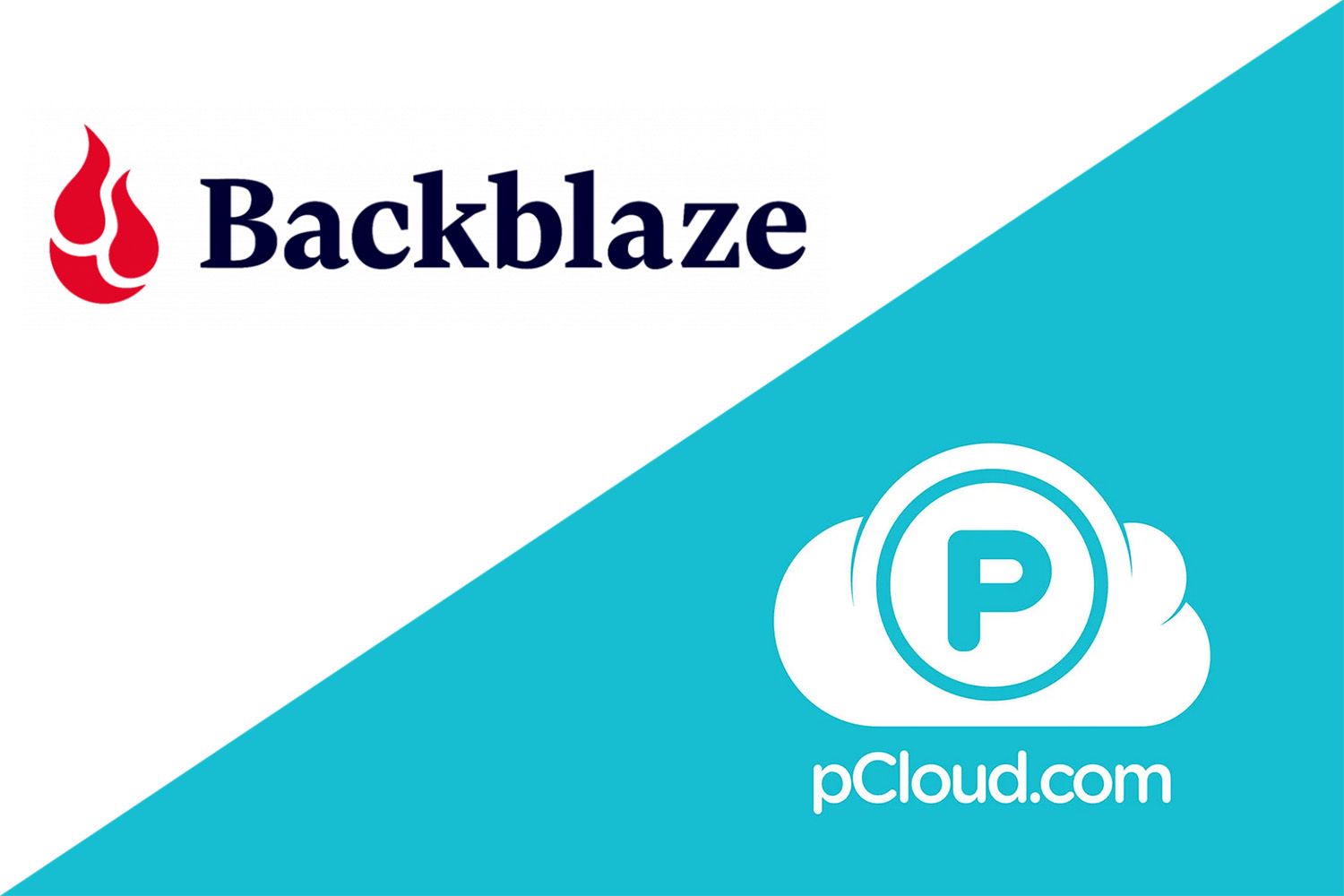
Backblaze vs pCloud: Apps and Compatibility
Our first pCloud vs Backblaze comparison will be in device compatibility and apps. In our opinion, Backblaze is a letdown in this regard. It does support all desktop and mobile platforms – including Linux – but ease of use, as you’ll see, isn’t the best.
We then have pCloud and its majestic apps for all platforms. It’s free to download and even Linux users can install and use it freely, with a GUI to make uploads and downloads swift. Backblaze relies too much on its web app which looks terrible.
On top of that, getting Backblaze to work can be complicated for many. It functions like pCloud at the start. You have to sign up with your email and password, after which, no verification is needed. You can start to use it right away and enjoy your 10 GB of space.
But then, you’ll find it hard to discover Backblaze’s app because there’s no access to it from your account. We had to Google “Download Backblaze”, find its backup client, and then download it. However, Backblaze immediately started to back up our files.
Wait a second, boy! It also wanted permission to access our location, which we promptly denied. pCloud “behaves” more docile. Once you install it, you’re in control and backups/uploads don’t start until you run them. Such a relief.
Backblaze
We’ll start with the web app here. You can see it’s bare as a desert. The first task is to create a bucket where you’ll store your files. Buckets are containers that store your files with or without encryption, as per your choice.
After you name the bucket and select the parameters like object lock, encryption, and whether you want your file to be public or private, you can upload your first file. However, you can’t upload files larger than 500 MB from the web interface.
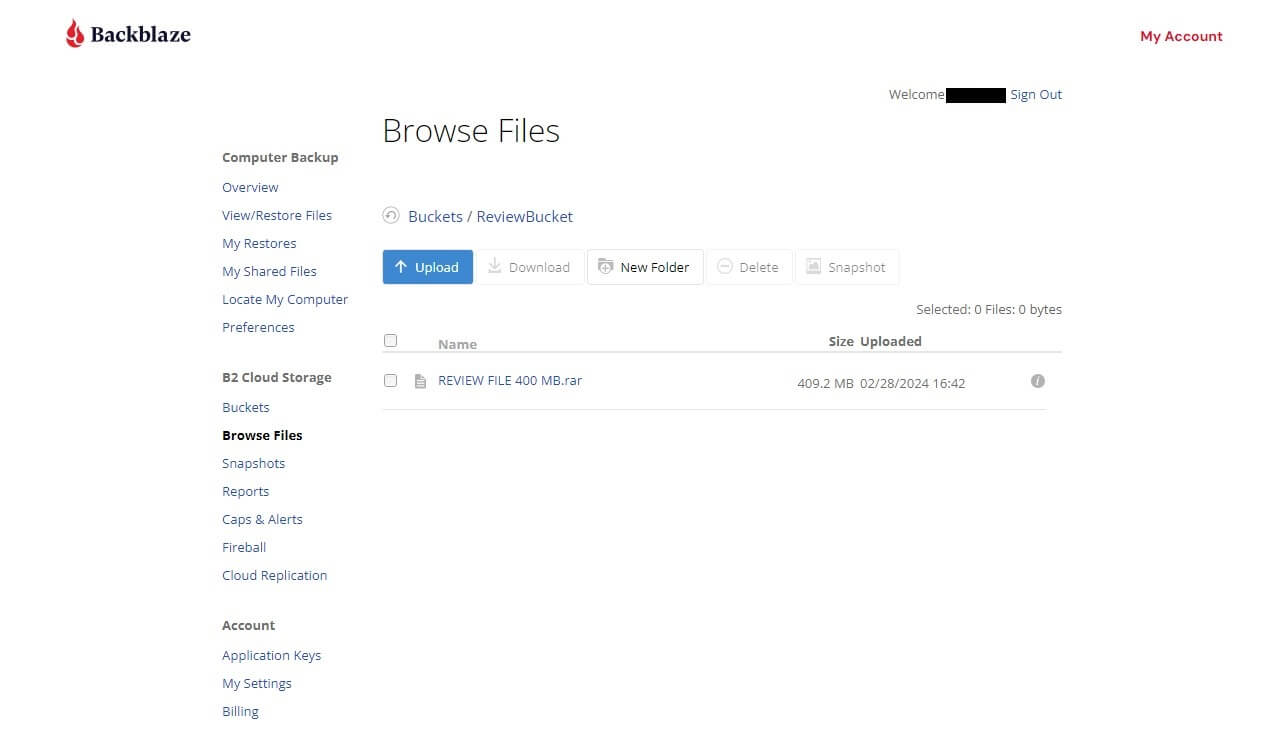
You then have to download a Backblaze B2 file on your PC, run it, and the command prompt function will be applied. However, that doesn’t help, as you still can’t upload a larger file. Neither you can via the desktop app – it doesn’t allow you to upload the file you want.
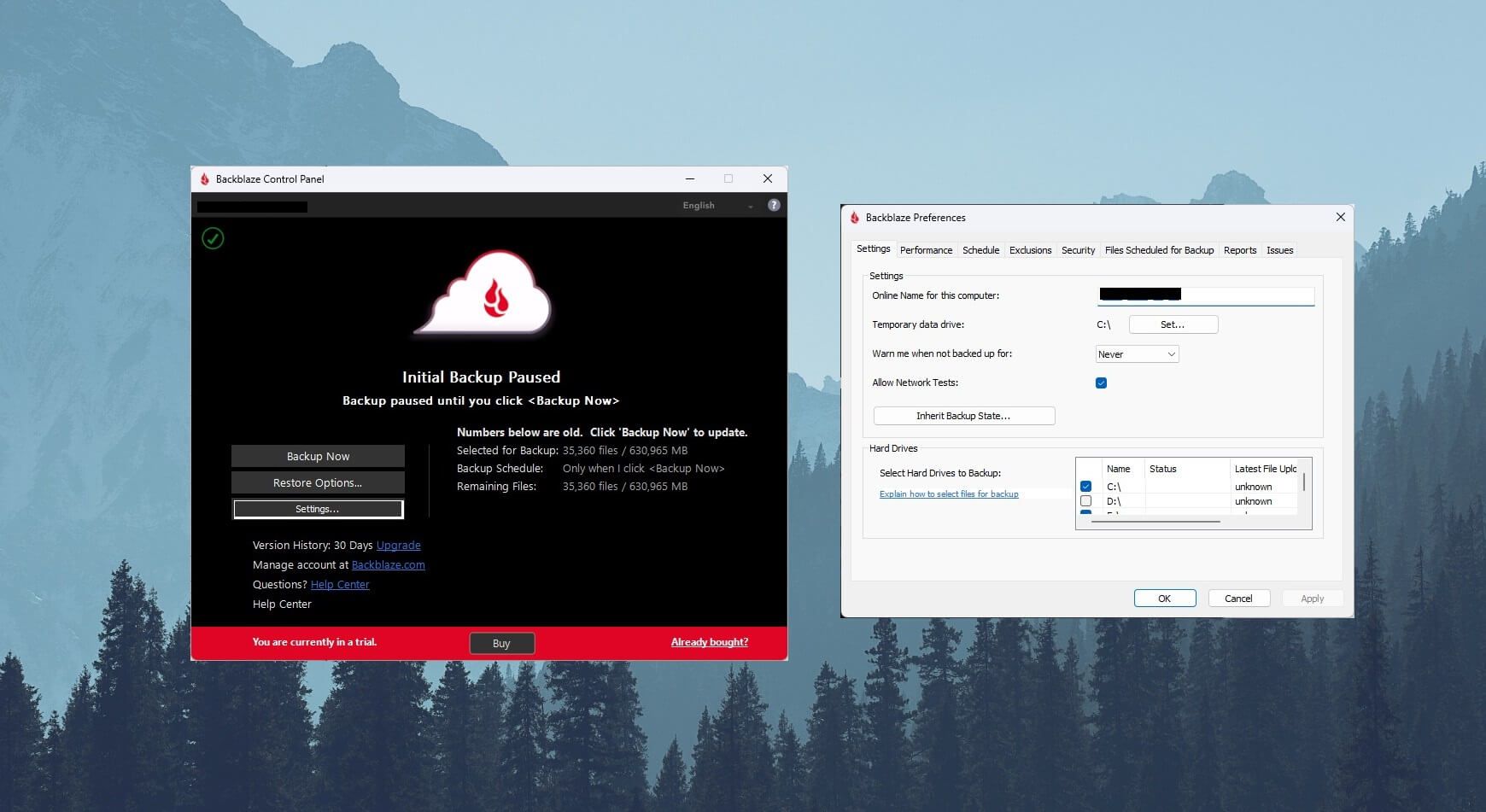
The desktop app looks like the one above. You have your restore options, settings, and the option to start the initial backup. In Settings, you’ll find options to manually throttle the performance, add a private encryption key, and see the files scheduled for backup.
As said, you can’t remove or add new files for backup, making Backblaze annoyingly unintuitive and worse than IDrive – a service we like a lot more. The mobile app is, again, outdated-looking but simple enough for an IT expert – just joking.
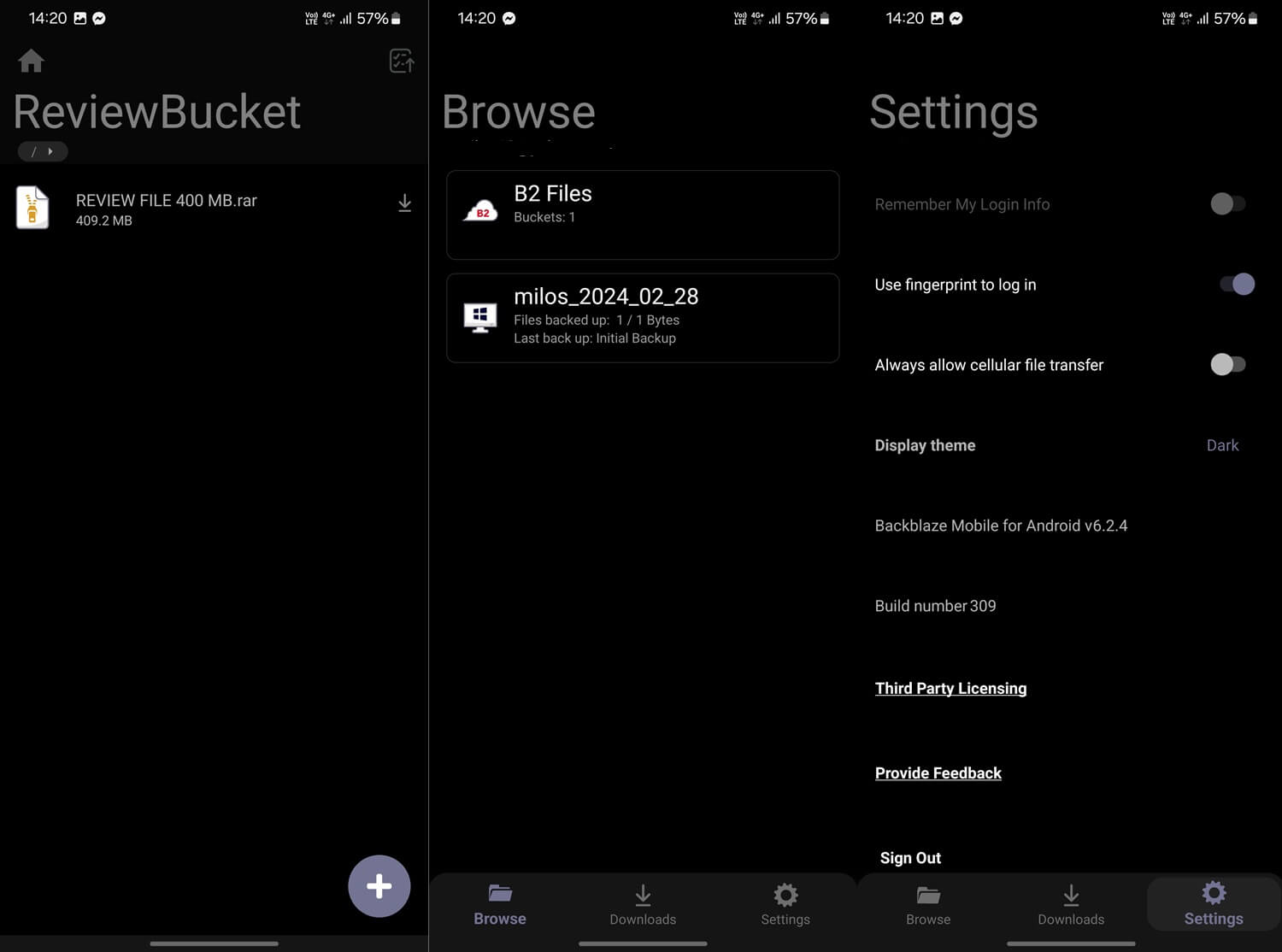
Backblaze is easy to install from Google Play/Apple Store and it allows for fingerprint sign-ins, which makes things simpler. From here, you can see your buckets and downloads, as well as upload your files to the bucket and restore them to your phone.
pCloud
In our Backblaze vs pCloud comparison, the second is superior. Its web app is very intuitive and allows you to upload and back up any file – be it 1 GB or 100 GB in size. The left side is reserved for your folders, shared files, file requests, and so on.
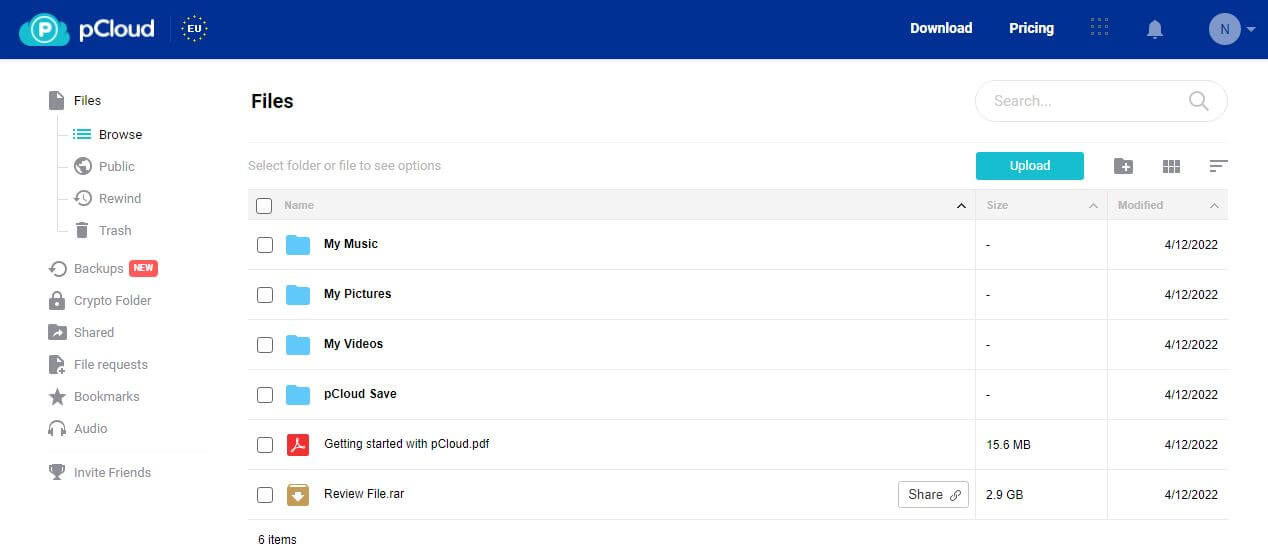
The middle portion of the web app will display your files in a browser-like style. You can open your folders and even preview audio, video, and document files. The desktop app is intuitive, too. It’s filled to the brim with easy-to-notice options and features.
This app displays your synced files and even allows you to perform backups to the cloud storage. You’ll also see this Crypto icon, which represents an encrypted cloud storage folder to keep your files safe from snoopers.
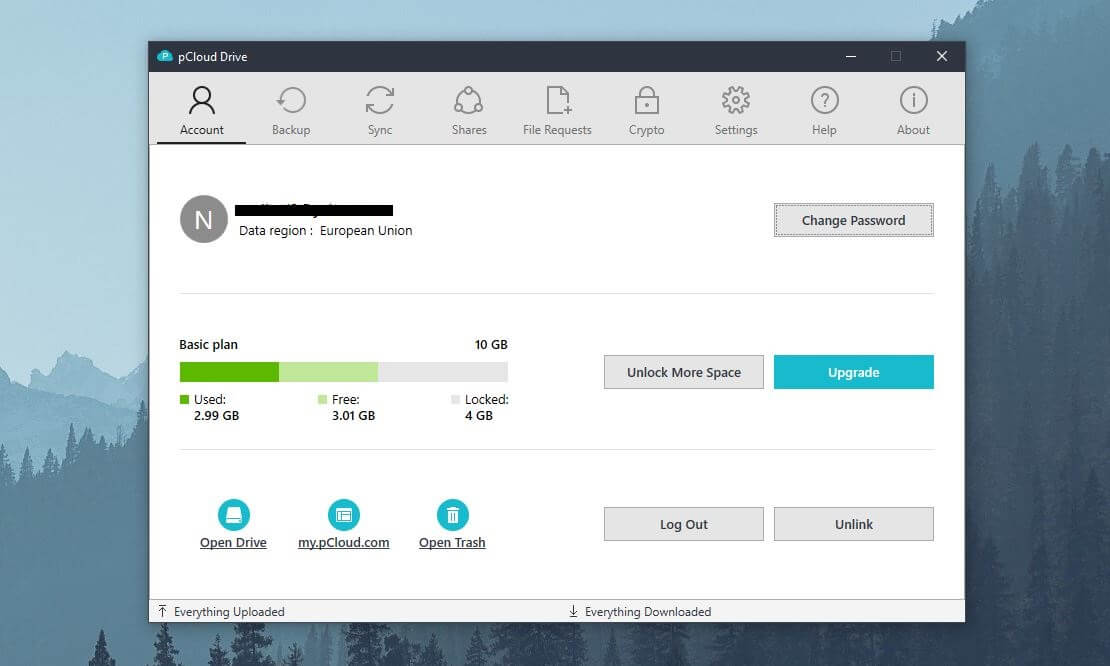
pCloud functions like a virtual drive on your computer – unlike Backblaze. This means you can transfer files by dragging and dropping them onto the drive. The overall user experience on Windows/macOS/Linux is so good that it makes Backblaze pale in comparison.
Oh, did we forget its mobile app? Below, you can see how good it looks. It’s a bog-standard cloud storage app for iOS/Android but that’s what we like. It offers a dark theme, which is a plus, and you get the explorer-style interface for easier access.
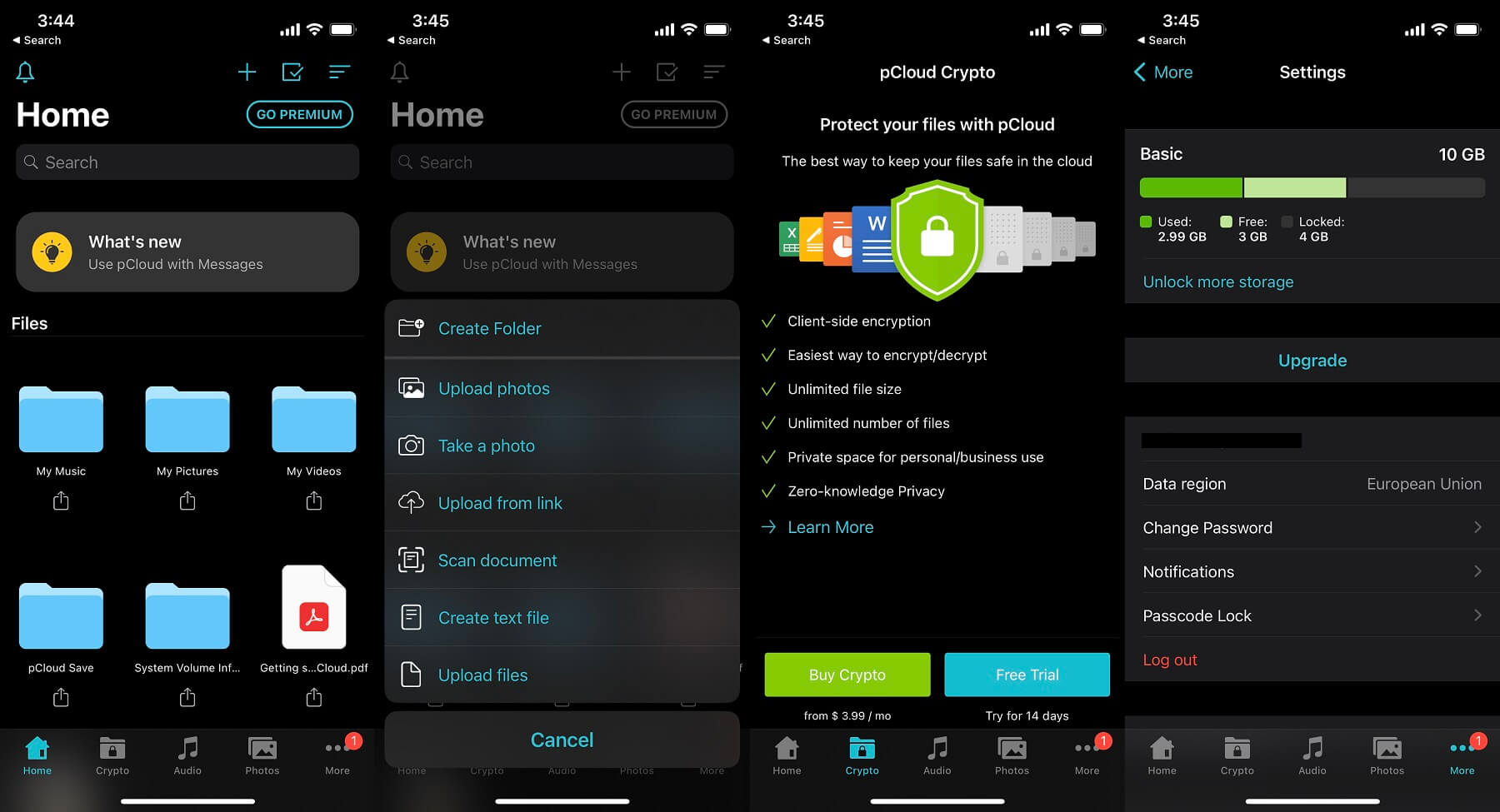
Users can create new folders, backup their phones, upload photos, and scan documents. We like that you can create text files directly on the cloud, which lets you take notes and access them promptly later on. The Crypto folder is here too, so encrypted files can be manipulated through your phone – nice!
Who Wins?
The first pCloud vs Backblaze comparison is crystal-clear. pCloud WINS because of its superior user experience across all of the supported platforms. Backblaze is too unintuitive and outdated, making it poor for newbies just getting into the cloud storage/backup services. pCloud is remarkable for both newbies and cloud storage experts.
Features of Backblaze and pCloud Compared
After our first test, pCloud has taken the lead over Backblaze and the score is now 1:0.
Will Backblaze be able to recover from such a devastating loss? Let’s discuss their features and see what they have to offer as cloud storage and backup service providers.
Backup Features
Since both services can be used for backups, it’s great to see their differences. In this pCloud vs Backblaze comparison, we tested both using various files and devices. We describe our experience below.
Backblaze
One of the key features of Backblaze is unlimited backups. This means you get unlimited storage for all your backups and the service operates on a per-device basis. In other words, it’s only about how many devices you can back up. Don’t worry about the storage.
Backup capabilities are great, albeit not better than IDrive. Also, we found it easy to back up our computer. We just had to select drives and let Backblaze do the job. An annoying thing is that you can’t unselect the system drive – it’s mandatory for backups.
Another thing we dislike is the lack of multi-device backups, which is especially annoying on iOS and Android devices. Believe it or not, you can’t back up your phone! Even Sync offers this feature, yet, it’s not a specialized backup service.
On the brighter side, in this pCloud vs Backblaze analysis, Backblaze offers continuous and incremental backup options. The second option is handy for altered files, as only their changed parts will need to be backed up, rather than the whole file from the start.
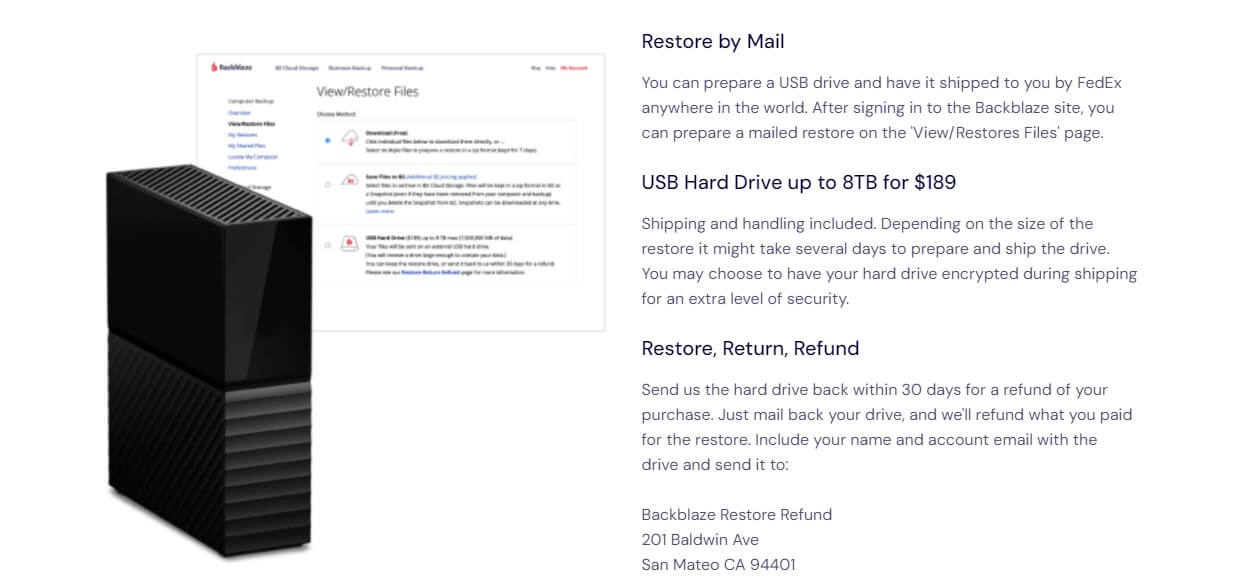
While we’re at that, Backblaze offers block-level transfers that do exactly what we described. Instead of transferring the entire document, let’s say, Backblaze will only transfer the edited part for added convenience and time saving.
Speaking of saving time, Backblaze allows you to exclude certain folders or drives from being backed up. Another perk is the option to restore your backed-up files by obtaining a hard drive with your files via a courier service from Backblaze.
If your PC gets damaged and you can’t repair it, instead of downloading terabytes of files, you can opt for this service instead. Bear in mind the service is $190 but if you return the drive to Backblaze, you’ll be refunded up to 5 times a year.
pCloud
Since pCloud isn’t a backup service, don’t expect robust features like the last one we mentioned in Backblaze. However, this doesn’t mean backups are impossible. pCloud’s desktop app contains the Backup menu – it’s very intuitive.
By default, pCloud will backup folders like:
- Desktop
- Documents
- Downloads
- Pictures
- Videos
- Music
However, users can choose other folders and ANY folder can make it to the list. Do you want to back up your system files? No problemo! Moreover, users can opt for an entire DRIVE as they’d do in Backblaze or IDrive. Once the choice is made, click on “Back Up” and you’re set.
pCloud doesn’t offer unlimited backups. Your storage is limited because this is a cloud storage provider first and foremost. This means your backups are dictated by the amount of storage you get, which can go up to 10 TB for Individuals. More about that later in the pCloud vs Backblaze analysis.
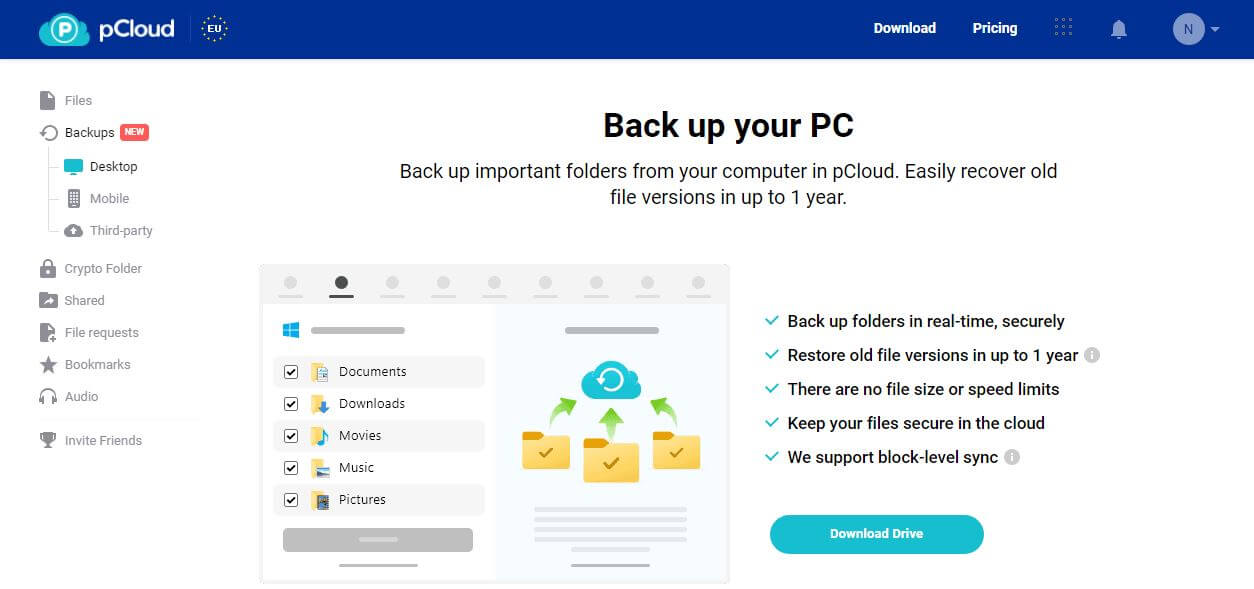
Like Backblaze, pCloud offers block-level transfers, allowing for faster uploads. We want to mention that you can also exclude certain folders and files. For example, you likely don’t need temporary files from your PC and thus, you don’t want them backed up.
A notable difference is multi-device backup. You see, pCloud can back up all your devices and even auto-back-ups are possible on mobile phones. You can set it up to automatically back up your photos and videos to the cloud, which we found nifty all the time.
Unfortunately, you’ll find no backup-specific quirks from Backblaze. Restoring your files via a physical drive is impossible but pCloud supports continuous and incremental backups.
File Versioning
When you back up the file to the cloud, you might want to keep its previous versions for a while. That’s where file versioning comes in. pCloud offers 30 days by default, which means it’ll preserve all file versions not older than 30 days.
There’s also the Rewind function, which lets you go back in time and examine all previous file versions, selecting the one you need. This also applies to thrash history, which is 30 days, and if you accidentally delete a file, you can dig it out of the recycle bin.
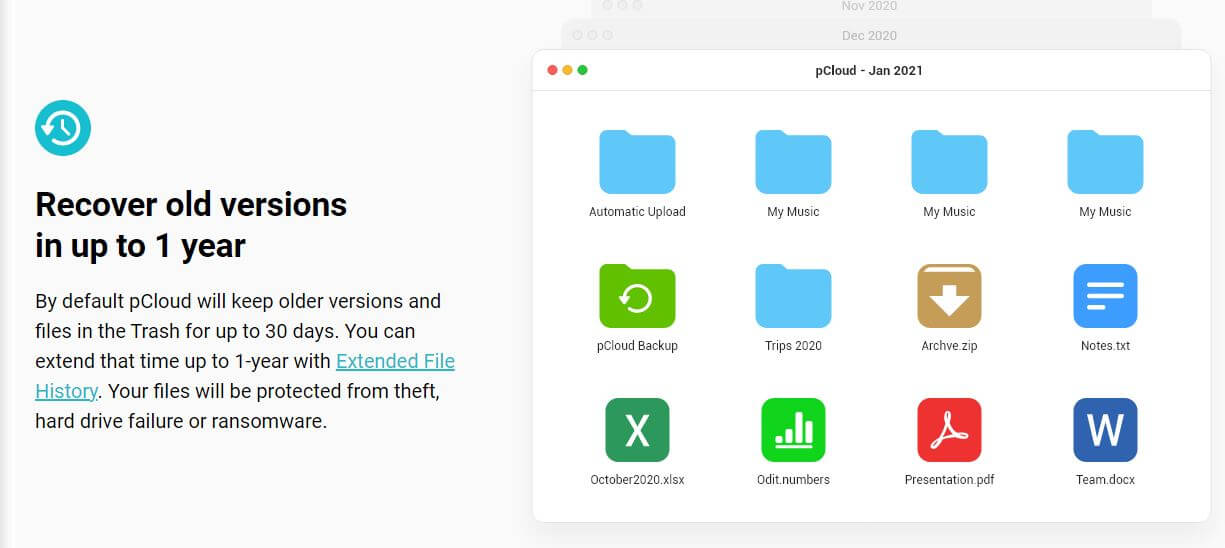
pCloud has something titled EFH, an abbreviation for Extended File History. It’s a paid addition that allows you to extend file versioning to 365 days. It is, however, more than $85 a year. So, pCloud or Backblaze, which offers longer file versioning?
That title goes to Backblaze – here’s why. By default, you’re getting 30 days of file versioning – standard stuff. Users can opt for 365 days too, but there’s the option to get the so-called “Forever Version History.” It means exactly that – keeping ALL your file versions perpetually.
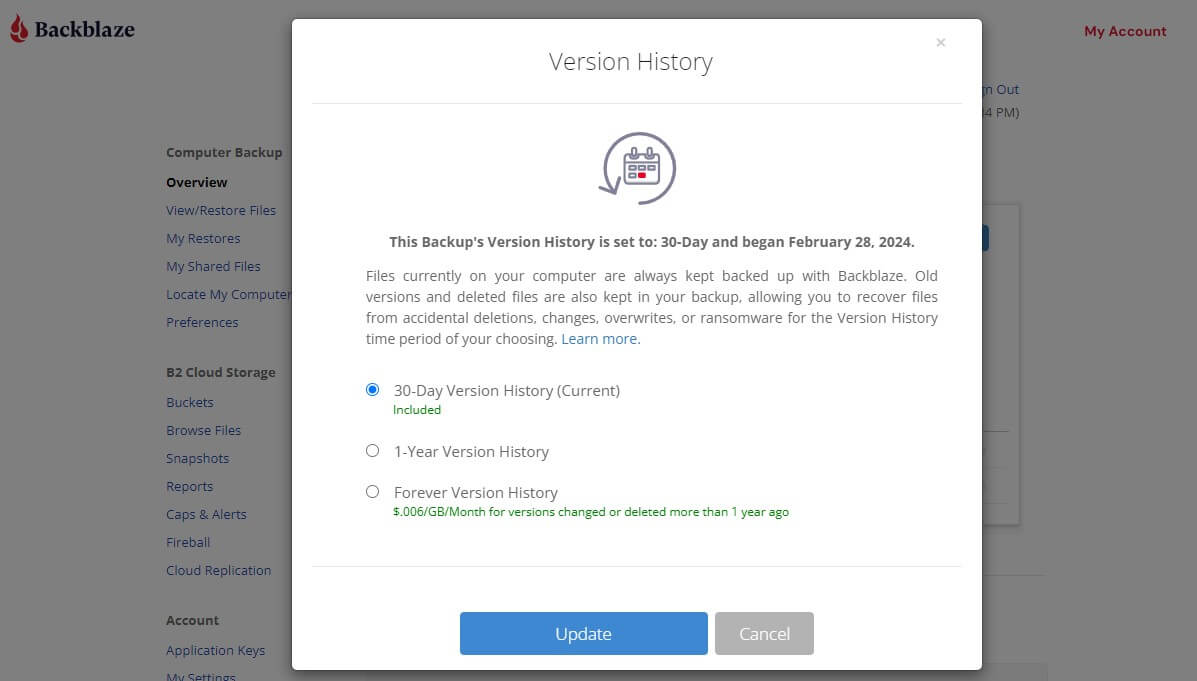
Backblaze charges you additionally for this and the option costs $0.006 per GB per month for versions deleted or changed more than 1 year ago. Larger file batches can end up being more expensive but if you mostly store documents, it ends up being pretty affordable.
It’s highly unlikely you’ll have 100 GB worth of documents unless you store 2,000-page books with PNG images or whatever.
File Sharing & Syncing
In our Backblaze vs pCloud comparison, we’ll promptly go over file sharing and syncing. Right away, we’ll tell you that Backblaze sucks for file sharing. At first, you won’t see the option for that but when you dig a bit, you’ll find it’s possible to share a file via a link.
pCloud trumps Backblaze for sharing photos, videos, and files in general. Once you click on the Share button, you’ll get a link, which you can password-protect, add an expiration date, or make it public for anyone to download.
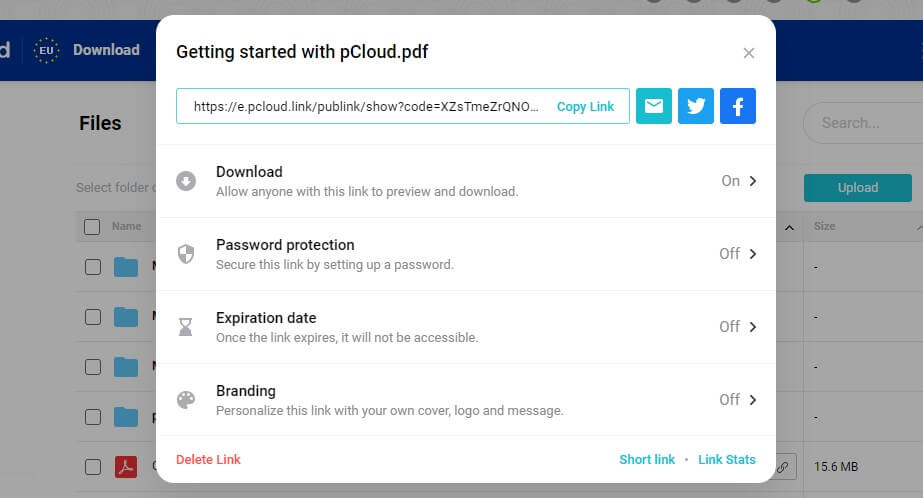
pCloud supports link branding. This lets you customize your link with a message, logo, or cover, which can be handy for business users. File syncing is also in pCloud, while Backblaze lacks this feature. Syncing will keep your files available across all devices.
You can choose which folders to sync and thanks to block-level sync, each incremental change will reflect the files on the cloud immediately. Thus, if you’re away from your PC, you can access the edited file on your phone. Pretty convenient.
Synced files and folders are connected to your devices. If you delete a file from the synced folder, it’ll be physically deleted from the computer and pCloud.
Upload/Download Speed Limiting
A handy feature we found in both is the ability to throttle your bandwidth. Why would you do that? To save up bandwidth for other processes. If you want to play games online and upload files simultaneously, reduce the upload speed to enjoy the game more.
pCloud and Backblaze allow you to do that in Settings. You can set the Auto option or use a custom value to limit upload and download speeds. Backblaze allows you to disable backups on battery power for laptops to preserve your battery.
Collaboration & Productivity Features
For productivity and collaboration, we love using Dropbox or Google Drive. pCloud and Backblaze aren’t champions in this category but Backblaze is extremely bad. It features no collaboration or productivity features, which is a bit disappointing.
Again, its rival IDrive features some of them. pCloud offers Shared Folders, where you can invite other pCloud users and assign different permissions. Some users can read, modify, create, or delete files in the shared folder, adding a sense of hierarchy.
We like that some users can only view the file but not modify it. Unlike Google Drive, pCloud won’t let you edit documents simultaneously with other users. Also, it doesn’t support document editing on the cloud, so each user must download the document first.
File Previews
At least, pCloud will let you preview files and documents, which Backblaze won’t. We transferred a few songs and documents to our Backblaze bucket, only to find that we could download them and not reproduce them. Shame.
pCloud can open PDF files and reproduce songs and video clips on the cloud. Moreover, the service includes an Audio section, where you can see your songs according to their albums and artists. Better yet, you can create a playlist!
This makes pCloud sort of a cloud-based media player for listening to music on the fly, without having to download it to your phone. In pCloud you can download videos by choosing from original and lower resolutions to save up some space.
Who Wins?
After our extensive testing in this Backblaze vs pCloud duel, we can say a couple of things. pCloud WINS overall because it’s more feature-rich and offers mobile backups, file previews, and better file-sharing options than Backblaze. What about Backblaze?
As expected, it’s a superior backup option with unlimited storage and block-level transfers. However, it lacks mobile backups, has no collab options, and it can’t preview files on the cloud.
Backblaze vs pCloud for Business & Teams
With the vast possibilities of these two, many businesses will be interested in getting their piece of cake. Are Backblaze and pCloud capable of business cloud/backup storage providers? Let us examine their plans in our pCloud vs Backblaze comparison.
Backblaze
Backblaze has a dedicated business plan akin to the personal plan. First, you need to enable Groups in your account and add multiple sub-users that belong to that account. As an administrator, you can control these users’ permissions.
The downside is that the service requires a license for each additional user, which… well, doesn’t sound like a dedicated business plan. We’ll get into its price later in this duel. Now, for the good stuff – each user gets unlimited storage for backups.
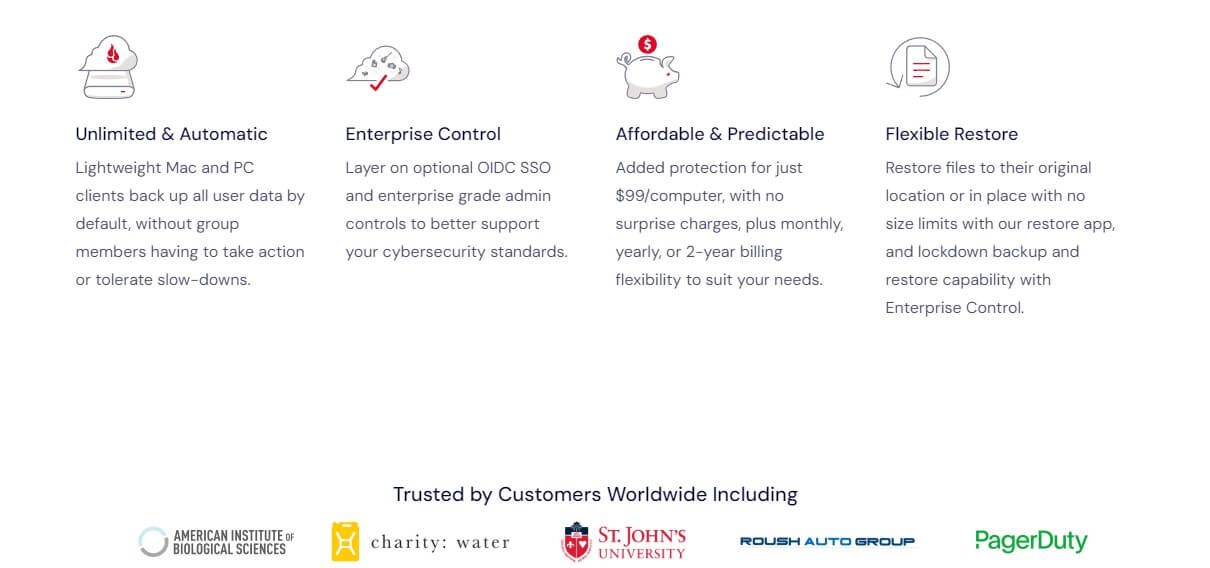
Furthermore, the Business plan supports NAS backups, for which you’ll need the so-called Backblaze B2 cloud storage. This, in turn, means you don’t have unlimited storage for NAS backups. Backblaze B2 is also pretty average, with subpar performance.
To put it simply, Backblaze charges you per device. Let’s say you’ll pay $9 per month per device on an individual plan. Well, the Business plan functions and even COSTS the same but you get to control all of the devices from one interface and account – sounds silly.
pCloud
pCloud goes down the traditional way. In our opinion, it’s a better business option, especially if the security of cloud storage is important to you.
The service offers its Business plan at just over $8.5 a month for the annual plan or over $11 a month for the monthly variant.

As you can see above, each user gets 1 TB of storage, and a minimum of 3 users are required. Both Business plans include pCloud Encryption, which we’ll discuss later, with secure file sharing, 180 days of file versioning, and an admin account.

A more capable Business Pro plan is above $17 a month or more than $21 a month for annual and monthly variants. pCloud used to offer unlimited storage but in 2025, that’s not the case. Instead, each user is assigned 2 TB of storage.
The only difference here, apart from that, is priority support, which is meaningful for pCloud whose customer support is… okay. In both cases, pCloud supports up to 99 users, so the entire storage can be up to 99 TB or 198 TB for the Business or Business Pro plan.
Who Wins?
Which is a better business cloud storage service – pCloud or Backblaze? We say that pCloud WINS. Its Business plans are more tailored to teams who want a centralized cloud storage space for storing and sharing files. Backblaze has nothing outstanding.
Yes, Backblaze has NAS backups but they’re limited, on top of which, the price is the same for additional user seats. Backblaze has unlimited storage which is more attractive but as it lacks collab and productivity features, business owners will likely prefer pCloud or Dropbox.
Which Cloud Storage Is Faster: pCloud or Backblaze?
Testing pCloud and Backblaze performance-wise is a vital step. Nobody likes slow uploads and downloads, especially when backing up their fortune of photos, videos, and documents to the cloud. For this Backblaze vs pCloud review, we took a different approach.
To ensure we can test web versions of both (the most used), we used a 400 MB file. Remember the 500 MB upload limit of Backblaze from the start? That’s why. We made a 400 MB RAR file with random music and photos and then uploaded it on both services.
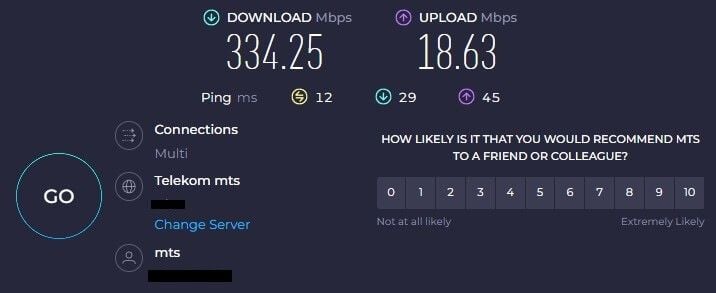
We did this to ensure Backblaze would properly upload the file. Above is our internet speed, with our upload speed of around 19 Mbps. After uploading the files to both cloud storage services, we downloaded them from both and measured upload and download times.
The results are below:
- Backblaze uploaded the file in around 5.6 minutes and downloaded it in 0.5 minutes.
- pCloud uploaded the file in roughly 2.6 minutes and downloaded it in 0.2 minutes.
We can see that pCloud’s uploads are MUCH faster than BackBlaze as the same file was uploaded roughly 50% faster. In the same fashion, pCloud beat Backblaze in download by completing it in just 12 instead of 30 seconds.
Who Wins?
Things couldn’t be cleared. pCloud WINS yet another round of this duel against Backblaze. Being faster in downloads and uploads, it’s more suitable for backing up and uploading large RAR files and documents, having them available on the cloud swiftly.
Security & Privacy of pCloud and Backblaze
If you’re going to let a cloud storage service keep your files, at least choose a secure one. pCloud and Backblaze are very opposite security and privacy-wise, and in this round, we’ll blitz through their features to see who is better.
Backblaze
Backblaze’s security is stellar overall. It uses secure physical data centers, with AES-128 encryption to keep your files intact. Transferred files are also encrypted with SSL encryption and on top of everything, the service implemented zero-knowledge encryption.
This implementation leaves a lot to be desired. For one, you have to enable it manually and then get your encryption key. However, to access your encrypted files, you have to decrypt them by providing the encryption key (private key) through the web client.
Providing your key to Backblaze violates the purpose of zero-knowledge encryption. Yes, it claims to not store private keys but if the server is compromised at the time of providing the key, you’re vulnerable to cyber attacks that could compromise your files.
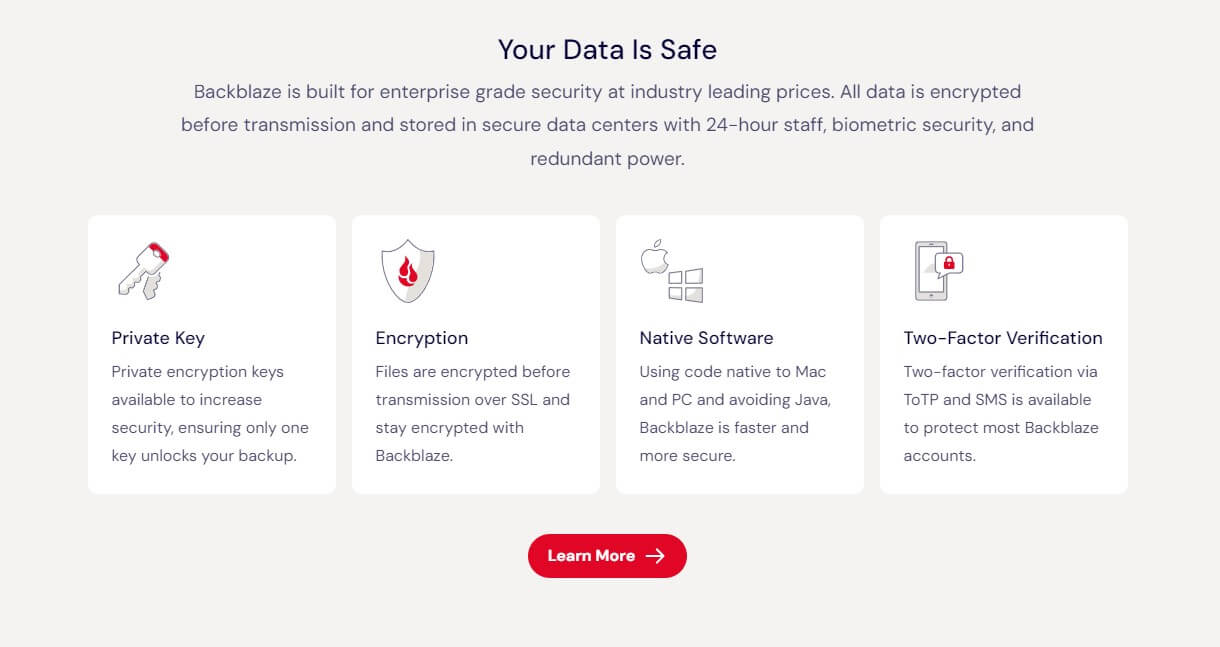
Apart from this, we found Backblaze to be pretty secure. Physical servers are secured against natural disasters and biometric security is implemented to prevent unauthorized access. Just don’t consider this a 100% encrypted cloud storage because it’s not.
pCloud, which also offers this function, won’t ever require you to hand out your encryption keys. Backblaze’s servers are in the US and the Netherlands, neither of which are privacy-friendly countries. However, the service didn’t have any privacy-related problems so far.
Its privacy policy is decent, so to speak, and the company won’t inspect your files and read your documents like Google Drive. However, it states that it can remove some of your files if they breach some of the policies on the site. This is a bit odd.
On one hand, Backblaze says that it can access your files only with your consent, so the whole paradigm is conflicting. Lastly, Backblaze isn’t HIPAA compliant – it’s GDPR compliant, however, so it respects EU privacy laws.
pCloud
pCloud is way safer than Backblaze. Its privacy policy states that the service won’t store any sensitive data, plus, the company is from Switzerland. It adheres to Swiss privacy laws which are one of the sternest in the world. Another point for pCloud is its encryption.
It employs TRUE zero-knowledge client-side encryption where you have the encryption keys. At no point will pCloud request them but if you lose them, your files are forever trapped in the Crypto folder and you can’t access them without these keys.
Besides, you’re not forced to use a web app. You can instead decrypt your files with the key on any platform – be it your phone or computer. Given its client-side nature, this encryption ensures not even pCloud’s employees can see your files, which is comforting.
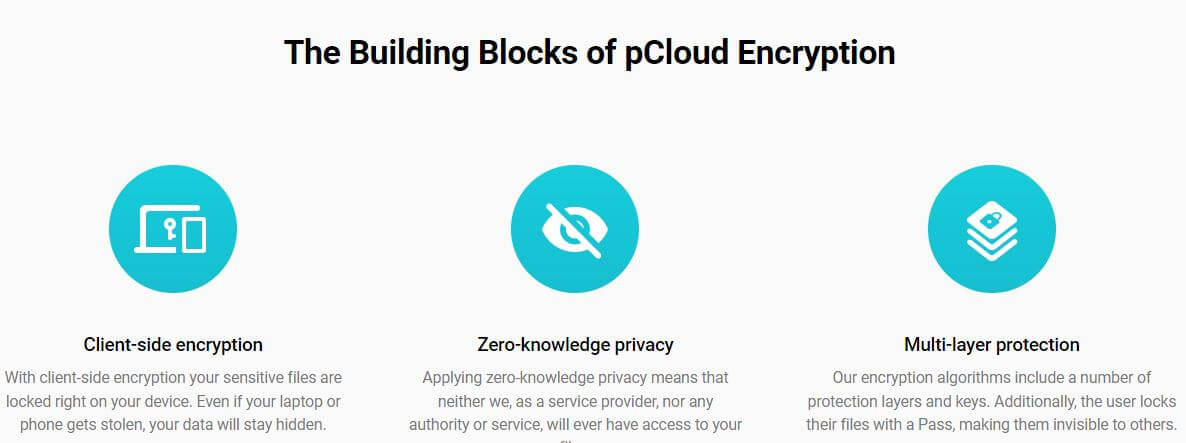
Regarding its data centers, pCloud has them in the US and Luxembourg. There’s also redundancy, which multiplies your files across several servers to make them accessible. If one server fails, another has your files. Oh, and you can choose your data center as well!
Those from Europe can, therefore, use the one from Luxembourg. pCloud uses TLS/SSL encryption to protect your file and zero-knowledge encryption is paid additionally, either monthly or annually. That’s the only bigger downside of this service.
On the other hand, pCloud is GDPR compliant and won’t ever access or mess with your files, even if zero-knowledge encryption isn’t enabled. Lastly, pCloud includes 2FA like Backblaze, which prevents unauthorized access from hackers and annoying snoopers.
Who Wins?
pCloud WINS this round, as it’s a safer and more secure cloud storage provider than Backblaze. We like its superior zero-knowledge encryption implementation, the fact that its privacy policy is more “private”, and servers in Luxembourg as a much safer location.
Backblaze features a poor zero-knowledge encryption solution and it’s based in the US, which opens up a few privacy concerns. Besides, it uses AES-128 encryption, whereas, pCloud relies on more powerful AES-256 encryption.
Customer Service: pCloud or Backblaze?
Customer support isn’t these services’ forte. pCloud relies on email support, which is faster to respond if you get priority support in the Business Pro plan. Backblaze follows in the same footsteps. Email support is here and you can submit a request on the site.
Backblaze and pCloud have many FAQs on their sites, on top of which, you’ll find a heap of how-to guides that explain certain problems and fixed in depth. We dislike that live chat support isn’t there like in some cloud storage services.
However, for the most part, pCloud and Backblaze are issue-free, so you won’t need to reach the support team that often.
Who Wins?
The customer service round is a DRAW. We noticed no particular differences between pCloud and Backblaze, and in our test, we had zero issues getting in touch with them.
Backblaze vs pCloud: Storage Options & Prices
Before we wrap up today’s comparison, we should go over the financial “moment” of these services. We’ll examine the price of pCloud and Backblaze to see which is cheaper and what you’ll end up getting from their subscription plans.
Backblaze
As said previously, Backblaze doesn’t charge you for storage. It charges you for each consequent device. If you want to back up only one computer, Backblaze will cost you $9 a month, $99 a year, or $189 every 2 years.
This price will give you everything we discussed in this pCloud vs Backblaze duel. If we’re discussing multiple users i.e. the “Business” plan, the price is the same. Let’s say you want to include two computers. That would be $18 a month, $198 a year, or $378 every 2 years.
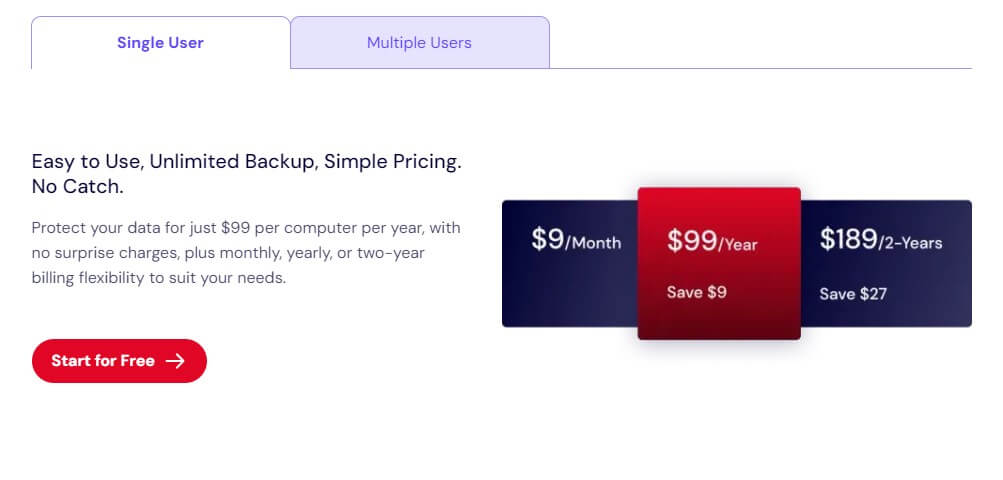
Backblaze includes no discounts for more devices, which is a shame. However, annual and biennial plans save you some money compared to the monthly deal. Backblaze B2 is there too, and it’s mostly for businesses. It offers the pay-as-you-go model.
In this case, you’ll pay $6 per TB per month. Annual capacity bundles are another option and Backblaze recommends the 250 TB of yearly storage at $19,500 every year. However, you’ll likely be interested in the Personal plans that we discussed previously.
Backblaze can be used for free, in which case, users will be granted 10 GB of storage.
pCloud
pCloud offers far better deals in our book. In particular, its lifetime plans are very enticing. The Ultra 10 TB plan will cost you a little over $1,300 and you’ll pay ONCE to enjoy a lifetime of this awesome cloud storage plan.
The service includes more lifetime deals, such as the Premium 2 TB Plus plan at over $430 and a 500 GB plan at over $210. Users can switch to annual plans if they deem lifetime deals too expensive. In this scenario, the 10 TB deal is unavailable.
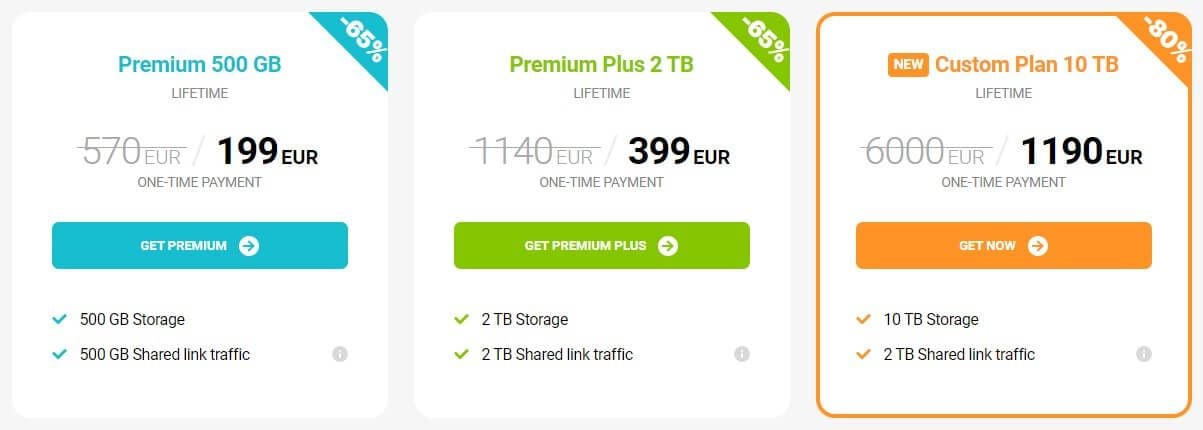
However, the 2 TB plan is here at over $110 a year, while the 500 GB plan is now over $57 annually. pCloud includes Family plans for those who need cloud storage for up to 5 people. These are lifetime deals with 2 TB and 10 TB of shared storage.
They cost over $640 and $1,620, with features like fair sharing, 30-day trash history, and many others. pCloud’s 10-day refund policy is impeccable and the provider has an amazing 10 GB free plan with 15 days of file versioning and impressive transfer speeds.
More about the top free cloud storage offers here.
Who Wins?
It’s hard to compare pCloud and Backblaze in the pricing section, as their pricing structures are built differently. pCloud surely isn’t the cheapest cloud storage but neither is Backblaze, especially if you’re looking to include more than one computer.
However, pCloud comes with lifetime deals that will save a tremendous amount of money in the long run. You’ll pay once and maybe spend a tad more but you’ll never have to pay again – the storage will be yours for as long as you exist.
That said, we can conclude that pCloud WINS the final round marginally, thanks to better overall deals and a handy 10-day money-back guarantee.
Conclusion: pCloud WINS Against Backblaze
The final score is 6:2 for pCloud – a service that emerges victorious. pCloud is undoubtedly better than Backblaze and its lackluster experience tainted by unintuitive apps, slow upload speeds, and the lack of file-sharing features that you’ll find in other competitors.
Backblaze offers unlimited backups, which we value but that’s not the case with NAS backups, for instance. pCloud is a cloud storage provider, so its features are more in line with cloud storage services, while also including impressive backup quirks.
In general, pCloud is a superior option and offers flexible plans, rock-solid security, and the fastest transfer speeds around. While not the cheapest by any means, our readers can get its exclusive discount underneath and save money on lifetime or annual plans.